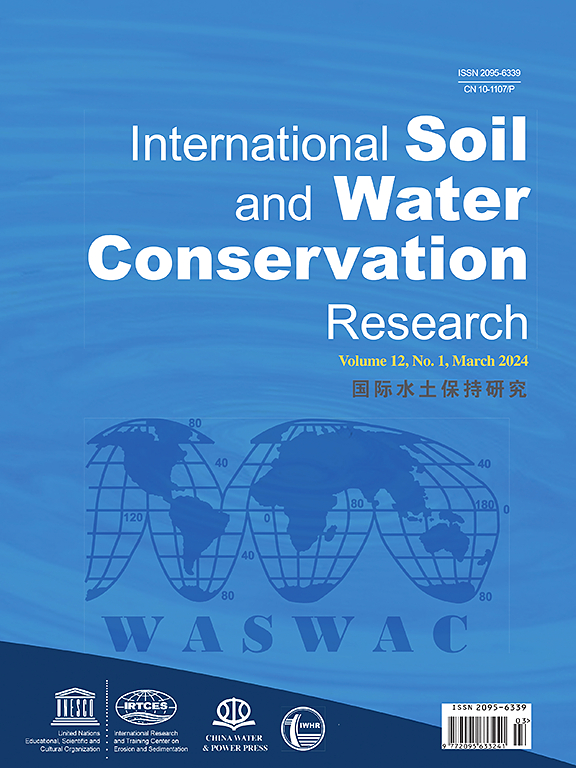Agroecology-based land use/land cover change detection, prediction and its implications for land degradation: A case study in the Upper Blue Nile Basin
IF 7.3
1区 农林科学
Q1 ENVIRONMENTAL SCIENCES
International Soil and Water Conservation Research
Pub Date : 2024-02-17
DOI:10.1016/j.iswcr.2024.02.002
引用次数: 0
Abstract
This study examined land use/land cover (LULC) changes in Chemoga watershed of the Upper Blue Nile Basin, comprising four distinct agroecological regions: Wet Wurch, Moist Dega, Moist Weyna Dega, and Moist Kolla. We used multi-temporal Landsat images from 1985 to 2020, a hybrid classification method and the Cellular Automata-Markov model to analyze historical and predict future (2020–2060) LULC changes under business-as-usual (BAU) and land conservation (LC) scenarios. Magnitudes and patterns of spaciotemporal LULC changes were analyzed using intensity analysis. Cropland expanded across all agroecologies from 1985 to 2020, with Moist Kolla experiencing the highest increase at the expense of woodland, due the introduction of commercial farming to this hotter, less populated and inaccessible area. Moist Dega exhibited the highest allocation changes within cropland and forest, attributable to farmers’ adoption of rotational land use to rehabilitate extensively degraded cultivated lands. Under the BAU scenario, projections suggest further cropland expansion at expense of woodland in Moist Kolla and built-up areas at the expense of cropland and grassland in Moist Dega. Under the LC scenario, forest cover is expected to increase at the expense of cropland across all agroecologies. The historical and projected BAU LULC change scenario substantially increased soil erosion and reduced ecosystem services. These effects can be minimized if LC scenario is properly implemented. The agroecology-based LULC intensity analysis reveals local drivers of change and associated impacts, providing vital insights for targeted land use planning in this study watershed and other watersheds facing similar challenges.
基于农业生态学的土地利用/土地覆被变化检测、预测及其对土地退化的影响:青尼罗河上游盆地案例研究
本研究考察了青尼罗河上游流域 Chemoga 流域的土地利用/土地覆被 (LULC) 变化情况,该流域由四个不同的农业生态区组成:湿润的 Wurch、湿润的 Dega、湿润的 Weyna Dega 和湿润的 Kolla。我们利用 1985 年至 2020 年的多时相大地遥感卫星图像、混合分类方法和细胞自动机-马尔可夫模型分析了历史上的 LULC 变化,并预测了在一切照旧(BAU)和土地保护(LC)情景下未来(2020-2060 年)的 LULC 变化。利用强度分析法分析了 LULC 空间时空变化的幅度和模式。从 1985 年到 2020 年,所有农业生态区域的耕地面积都有所扩大,其中湿润科拉(Moist Kolla)地区的耕地面积增幅最大,但林地面积却减少了,原因是在这一较炎热、人口较少且交通不便的地区引入了商业化耕作。德加湿润地区的耕地和林地分配变化最大,原因是农民采用轮作方式恢复大面积退化的耕地。在 "一切照旧 "情景下,预测结果表明,在 Moist Kolla,耕地面积进一步扩大,但林地面积却减少了;在 Moist Dega,建筑区面积扩大,但耕地和草地面积却减少了。在低碳经济情景下,预计所有农业生态的森林覆盖率都将增加,但耕地面积将减少。历史和预测的 BAU LULC 变化情景大大增加了土壤侵蚀,减少了生态系统服务。如果适当实施低碳方案,这些影响可以降到最低。基于农业生态的 LULC 强度分析揭示了当地的变化驱动因素和相关影响,为本研究流域和其他面临类似挑战的流域进行有针对性的土地利用规划提供了重要见解。
本文章由计算机程序翻译,如有差异,请以英文原文为准。
求助全文
约1分钟内获得全文
求助全文
来源期刊

International Soil and Water Conservation Research
Agricultural and Biological Sciences-Agronomy and Crop Science
CiteScore
12.00
自引率
3.10%
发文量
171
审稿时长
49 days
期刊介绍:
The International Soil and Water Conservation Research (ISWCR), the official journal of World Association of Soil and Water Conservation (WASWAC) http://www.waswac.org, is a multidisciplinary journal of soil and water conservation research, practice, policy, and perspectives. It aims to disseminate new knowledge and promote the practice of soil and water conservation.
The scope of International Soil and Water Conservation Research includes research, strategies, and technologies for prediction, prevention, and protection of soil and water resources. It deals with identification, characterization, and modeling; dynamic monitoring and evaluation; assessment and management of conservation practice and creation and implementation of quality standards.
Examples of appropriate topical areas include (but are not limited to):
• Conservation models, tools, and technologies
• Conservation agricultural
• Soil health resources, indicators, assessment, and management
• Land degradation
• Sustainable development
• Soil erosion and its control
• Soil erosion processes
• Water resources assessment and management
• Watershed management
• Soil erosion models
• Literature review on topics related soil and water conservation research
 求助内容:
求助内容: 应助结果提醒方式:
应助结果提醒方式:


